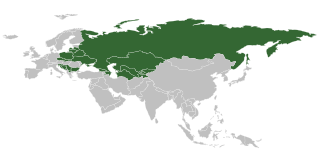Lieutenant general is a military rank used in many countries. The rank originates from the Old European System. The rank traces its origins to the Middle Ages, where the title of lieutenant general was held by the second-in-command on the battlefield, who was normally subordinate to a captain general.
Gefreiter is a German, Swiss and Austrian military rank that has existed since the 16th century. It is usually the second rank or grade to which an enlisted soldier, airman or sailor could be promoted.
Army general is the highest ranked general officer in many countries that use the French Revolutionary System. Army general is normally the highest rank used in peacetime.
Starshina is a senior military rank or designation in the military forces of some Slavic states, and a historical military designation. Depending on a country, it had different meanings. In the 19th century with the expansion of the Imperial Russia into Turkestan and the Central Asia, the word was even used to identify some Turkic leaders as a basic Russian word for aqsaqal (white-beard).

Polkovnik is a military rank used mostly in Slavic-speaking countries which corresponds to a colonel in English-speaking states, coronel in Spanish and Portuguese-speaking states and oberst in several German-speaking and Scandinavian countries. It was originally a rank in the Polish–Lithuanian Commonwealth and the Russian Empire. However, in Cossack Hetmanate and Sloboda Ukraine, polkovnyk was an administrative rank similar to a governor. Usually this word is translated as colonel, however the transliteration is also in common usage, for the sake of the historical and social context. Polkovnik began as a commander of a distinct group of troops (polk), arranged for battle.
Praporshchik is a rank used by the Russian Armed Forces and a number of former communist states. The rank is a non-commissioned officer's and is equivalent to Michman in the corresponding navies. It is usually equivalent to warrant officer class 1 or sergeant major in English-speaking armies. Within NATO forces, the rank is rated as OR-7 or OR-8.

Podpolkovnik is a military rank in Slavic and nearby countries which corresponds to the lieutenant colonel in the English-speaking states and military.
Senior lieutenant is a military grade between a lieutenant and a captain, often used by countries from the former Eastern Bloc. It is comparable to first lieutenant.
Junior lieutenant is a junior officer rank in several countries, comparable to Sub-lieutenant.
A junior sergeant is a military rank used in multiple militaries across the world. It is usually placed below sergeant.
A Senior sergeant is a rank of non-commissioned officer used in the armed forces of many nations. It is usually placed above sergeant.
Major general is a military rank used in many countries. It is derived from the older rank of sergeant major general.
Colonel general is a military rank used in some armies. The rank originates from the Old European System and it is particularly associated with Germany, where historically general officer ranks were one grade lower than in the Commonwealth and the United States, and Generaloberst was a rank above full General, but below Generalfeldmarschall. The rank of colonel general also exists in the armed forces organized along the lines of the Soviet model, where it is comparable to that of a lieutenant general.

The Ministry of Defence of Tajikistan is the defence ministry of Tajikistan, overseeing the Tajik Ground Forces, Air Force, Mobile Forces. It also oversees purchases of equipment for the Tajik military. The other branches of the military, such as the Border and Internal Troops, are overseen by the Interior Ministry of Tajikistan. The Defence Ministry was founded in 1993 with Russian assistance.
Rank comparison chart of armies and land forces of Asian states.
Starshy praporshchik is a rank used by the Russian Ground Forces and a number of former communist states. The rank is a non-commissioned officer's and is equivalent to Starshy michman in navies. It is usually equivalent to warrant officer class 1 or sergeant major in English-speaking armies.
Rank comparison chart of non-commissioned officers and other personnel for armies/ land forces of Asian states.

The Tajikistan Independence Day Military Parade is the main event of the Independence Day of Tajikistan. This parade is held every 5 years in Dushanbe on September 9. The participants in the parade are from agencies of the Armed Forces of the Republic of Tajikistan. The parade route is made up of Rudaki Avenue, Dousti Square and Hofizi Sherozi Avenue.
Rank comparison chart of all armies of Post-Soviet states.
Rank comparison chart of enlisted for all armies of Post-Soviet states.
































